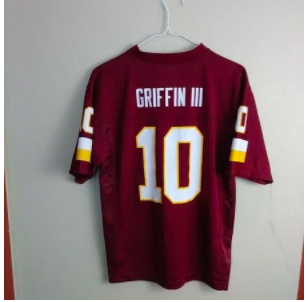“Professional sports brands and leagues would do well to work with retailers to understand how bad actors are fooling fans, the types of platforms they’re leveraging for their illegal activity, and how recent events will impact their businesses before it’s too late.”
 The Washington Football Team’s (formerly the Washington Redskins’) move to change its name and logo has sparked a flurry of fans looking to “cash in” as national retailers pull the team’s merchandise off their shelves. Fans everywhere are hoping to snatch up any remaining Redskins-branded memorabilia they think may be worth money someday, which in turn is putting them at risk of purchasing knockoff items. Advancements in technology have made it harder to discern between what’s fake and what’s authentic, and the rush to find Redskins gear may make things worse as fans make snap-purchasing decisions and accidentally buy a knockoff item.
The Washington Football Team’s (formerly the Washington Redskins’) move to change its name and logo has sparked a flurry of fans looking to “cash in” as national retailers pull the team’s merchandise off their shelves. Fans everywhere are hoping to snatch up any remaining Redskins-branded memorabilia they think may be worth money someday, which in turn is putting them at risk of purchasing knockoff items. Advancements in technology have made it harder to discern between what’s fake and what’s authentic, and the rush to find Redskins gear may make things worse as fans make snap-purchasing decisions and accidentally buy a knockoff item.
A Changing Landscape for Counterfeits
Before the e-commerce boom of the last decade or so, the distribution of counterfeit sports merchandise, like team jerseys, was through street vendors, who were easier to police. Now, in another spike, the rise of e-commerce and the numerous channels available to consumers with just one click have opened up doors for scammers to reach even the savviest shopper, or on the flip side, consumers looking for a bargain who only care about whether a knockoff item looks close to authentic. Sites are plentiful, and owners are often untraceable, operating through false identities. The problem becomes even more complex where sellers hide trusted platforms like Amazon, eBay and Alibaba, which means establishing solid partnership with these trusted marketplaces is more important than ever to double down on exposing these bad actors.
Fueled by the advent of social media, counterfeiters continuously move and expand their methods of reaching consumers by slipping into channels like Facebook, Instagram, TikTok and, more recently, messaging apps like WeChat and WhatsApp, to promote their copycat products, hoping to remain undetected. We rely on these social media platforms to police content, but they need solid partners to support their efforts. Even the most tech-savvy consumers are sometimes tricked by these advertisements, which can often result in lost revenue for retailers and a hit to their image.
Counterfeiting as a whole is expected to be a $4.2 trillion industry by 2022, and sports merchandise is not immune to this problem. Overall, the rapid growth of online counterfeiting is affecting brands in the sportswear and fitness equipment industries worldwide – 20% of sportswear consumers have admitted to buying a fake online, and 46% have indicated they would think less of a brand if they found large numbers of counterfeits online. The problem has become so bad that Immigration and Customs Enforcement (ICE) launched an initiative in 2013 to halt the importation of counterfeit sports and entertainment merchandise. Named “Operation Team Player,” following the 2019 Super Bowl the campaign resulted in the capture of $24.2 million worth of fake sports merchandise. Earlier this year, ICE seized over $123 million worth of counterfeit Super Bowl merchandise in the form of fake jerseys, hats, jewelry, cell phone accessories and other items branded with Kansas City Chiefs and San Francisco 49ers logos. That’s a 400% increase over the previous year. While this can be considered a huge win for sports brands, it’s also a clear sign that we still have a long way to go in cracking down on counterfeiters.
Counterfeits and Coronavirus
Now, the coronavirus outbreak has exacerbated this issue. Since the pandemic intensified, shoppers were forced to rely on e-commerce for everything from games to cleaning products and even the most basic essentials. In total, 60.4% of consumers increased online shopping over in-store since lockdown orders went into effect, making consumers vulnerable to the rising number of counterfeit goods online. From March to April, the number of counterfeit detections increased 38% across apparel, toys, home goods, accessories, and sporting goods, and in Q2, the number of counterfeit incidents in regard to sports merchandise jumped 110%. The chaos of the pandemic, coupled with occurrences like ending the sale of Redskins merchandise, leaves an opening for counterfeiters, who, like hackers, are extremely opportunistic. As loyal fans realize their options are limited and turn to scouring all corners of the internet, counterfeiters are seizing the opportunity to prey on their fears.
Raise Awareness
Professional sports brands and leagues would do well to work with retailers to understand how these bad actors are fooling fans, the types of platforms they’re leveraging for their illegal activity, and how recent events will impact their businesses – revenue, brand loyalty, etc. – before it’s too late. While monitoring these channels, brands should also take initiative by informing their fans via social media or on their own websites that counterfeits are produced in inhumane factories, likely using children in those factories, and often associated with organized criminal activity. It is through action and raising awareness that sports brands will be able to minimize risk and protect their fans.

![[IPWatchdog Logo]](https://ipwatchdog.com/wp-content/themes/IPWatchdog%20-%202023/assets/images/temp/logo-small@2x.png)

![[Advertisement]](https://ipwatchdog.com/wp-content/uploads/2024/04/Artificial-Intelligence-2024-REPLAY-sidebar-700x500-corrected.jpg)
![[Advertisement]](https://ipwatchdog.com/wp-content/uploads/2024/04/Patent-Litigation-Masters-2024-sidebar-700x500-1.jpg)

![[Advertisement]](https://ipwatchdog.com/wp-content/uploads/2021/12/WEBINAR-336-x-280-px.png)
![[Advertisement]](https://ipwatchdog.com/wp-content/uploads/2021/12/2021-Patent-Practice-on-Demand-recorded-Feb-2021-336-x-280.jpg)
![[Advertisement]](https://ipwatchdog.com/wp-content/uploads/2021/12/Ad-4-The-Invent-Patent-System™.png)






Join the Discussion
2 comments so far.
Anon
September 15, 2020 09:08 amMr. Lewis,
I think that it is less on point as to the motivation of any one buying up such material with the logos in question and would be MORE on point as to the fact that such items with logos in question are still being sold.
If the owner of the logos in question were truly “socially concerned,” would they not – not only stop selling, but also be looking to gather up as much of the “socially offensive” material for destruction?
Looking towards some type of control of thoughts and feelings of purchasers is looking in the wrong direction.
David Lewis
September 14, 2020 04:06 pmYou got to wonder, how many of the fans that are buying up all these jerseys supportive of the reason why the team is changing its name? To state the obvious, it would seem to be contradictory to be willing to cash in on the name change by buying jerseys with the old name and also support the reasons for the name change.